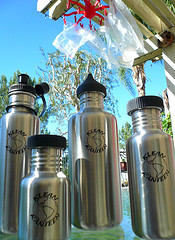- 1 read

We are living in a time when environmental innovations are shifting our daily lives. All of the media hype nowadays tells us that the plastic water bottles we buy from the store are about as much “green” as the color red, from their manufacturing pollution through their common landfill disposal. For those of us needing to quench our thirsts at all hours of the day, the increasingly-popular stainless steel water bottle seems to be the eco-friendly solution. Durable and reusable (unless you lose the top), they free us from ever needing to purchase another plastic bottle again, thus saving money and the environment. But actually how much more environmentally-friendly are stainless steel bottles? A look at the steel process shows us that we may be quite in the gray about what is “green.”
Steel is composed of several essential metals that must be mined out of the ground. Mining generates its own environmental impacts on the land, and some of the ores, such as chromium ore, can be carcinogenic to the workers. After the ores are extracted from the earth they must undergo extensive heat processes, which require incredible amounts of energy from fossil fuels and release greenhouse gases, cancer-causing toxins, and particulates into the environment. The entire extraction and manufacturing process is a global succession of approximately 1400 inputs, each with its own environmental footprint.
From there, the bottle must be shipped from the factory to the store. This requires oil and energy which contribute to greenhouse gas emissions, particulate matter, and other emissions. Even so, a bottle shipped from Asia to the US (plus a few extra hundred miles of trucking) adds just 1 to 5 percent of its total environmental damage—but the store you buy it from, with its heating, cooling, and ventilation, may have just as harmful an effect on the environment as the bottle.
Stainless steel water bottles are reusable, but only if they are cleaned regularly to prevent the hazardous buildup of bacteria. Washing a water bottle 50 to 100 times in an electrically-heated dishwasher can cause as much pollution as it took to simply make the bottle in the first place.
So it would seem then that buying a stainless steel bottle is much worse for the environment than buying a plastic bottle. Producing one stainless steel bottle requires 7 times the amount of fossil fuels and results in 14 times more greenhouse gases than producing one plastic water bottle. However, chances are that you will have more than one drink of water in your life, and buying a stainless steel bottle probably means that you will reuse it over and over again instead of continuously buying unsustainable plastic bottles. At the end of the day, if you use your stainless steel water bottle 50 times the climate is better off from all of the saved plastic production, and using it 500 times beats plastic in every aspect of its life cycle. Even though there is social pressure calling for a shift towards sustainability, we need to be careful that our substitutes are indeed better for the environment.

